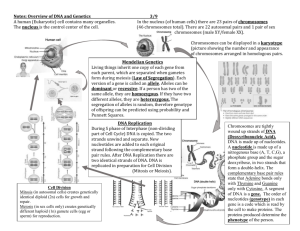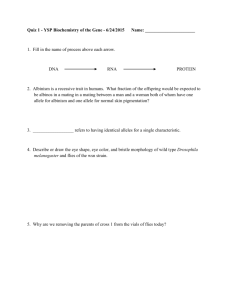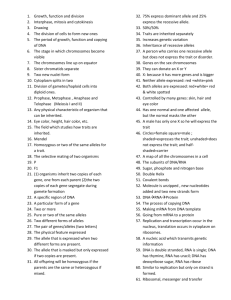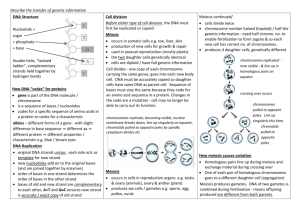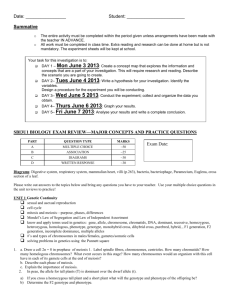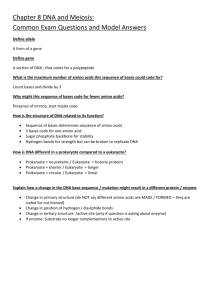Genetics survival sheet
advertisement
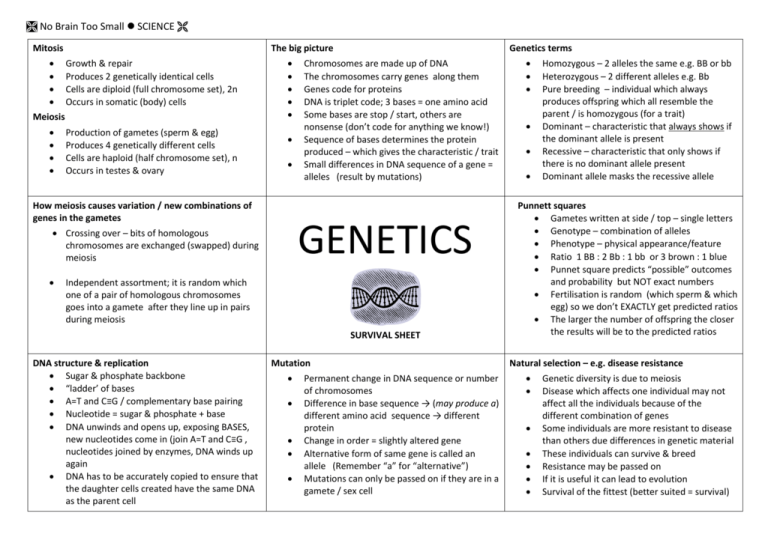
No Brain Too Small SCIENCE Mitosis The big picture Growth & repair Produces 2 genetically identical cells Cells are diploid (full chromosome set), 2n Occurs in somatic (body) cells Meiosis Production of gametes (sperm & egg) Produces 4 genetically different cells Cells are haploid (half chromosome set), n Occurs in testes & ovary How meiosis causes variation / new combinations of genes in the gametes Chromosomes are made up of DNA The chromosomes carry genes along them Genes code for proteins DNA is triplet code; 3 bases = one amino acid Some bases are stop / start, others are nonsense (don’t code for anything we know!) Sequence of bases determines the protein produced – which gives the characteristic / trait Small differences in DNA sequence of a gene = alleles (result by mutations) GENETICS Crossing over – bits of homologous chromosomes are exchanged (swapped) during meiosis Genetics terms Independent assortment; it is random which one of a pair of homologous chromosomes goes into a gamete after they line up in pairs during meiosis SURVIVAL SHEET DNA structure & replication Sugar & phosphate backbone “ladder’ of bases A=T and C≡G / complementary base pairing Nucleotide = sugar & phosphate + base DNA unwinds and opens up, exposing BASES, new nucleotides come in (join A=T and C≡G , nucleotides joined by enzymes, DNA winds up again DNA has to be accurately copied to ensure that the daughter cells created have the same DNA as the parent cell Mutation Permanent change in DNA sequence or number of chromosomes Difference in base sequence → (may produce a) different amino acid sequence → different protein Change in order = slightly altered gene Alternative form of same gene is called an allele (Remember “a” for “alternative”) Mutations can only be passed on if they are in a gamete / sex cell Homozygous – 2 alleles the same e.g. BB or bb Heterozygous – 2 different alleles e.g. Bb Pure breeding – individual which always produces offspring which all resemble the parent / is homozygous (for a trait) Dominant – characteristic that always shows if the dominant allele is present Recessive – characteristic that only shows if there is no dominant allele present Dominant allele masks the recessive allele Punnett squares Gametes written at side / top – single letters Genotype – combination of alleles Phenotype – physical appearance/feature Ratio 1 BB : 2 Bb : 1 bb or 3 brown : 1 blue Punnet square predicts “possible” outcomes and probability but NOT exact numbers Fertilisation is random (which sperm & which egg) so we don’t EXACTLY get predicted ratios The larger the number of offspring the closer the results will be to the predicted ratios Natural selection – e.g. disease resistance Genetic diversity is due to meiosis Disease which affects one individual may not affect all the individuals because of the different combination of genes Some individuals are more resistant to disease than others due differences in genetic material These individuals can survive & breed Resistance may be passed on If it is useful it can lead to evolution Survival of the fittest (better suited = survival) No Brain Too Small SCIENCE

